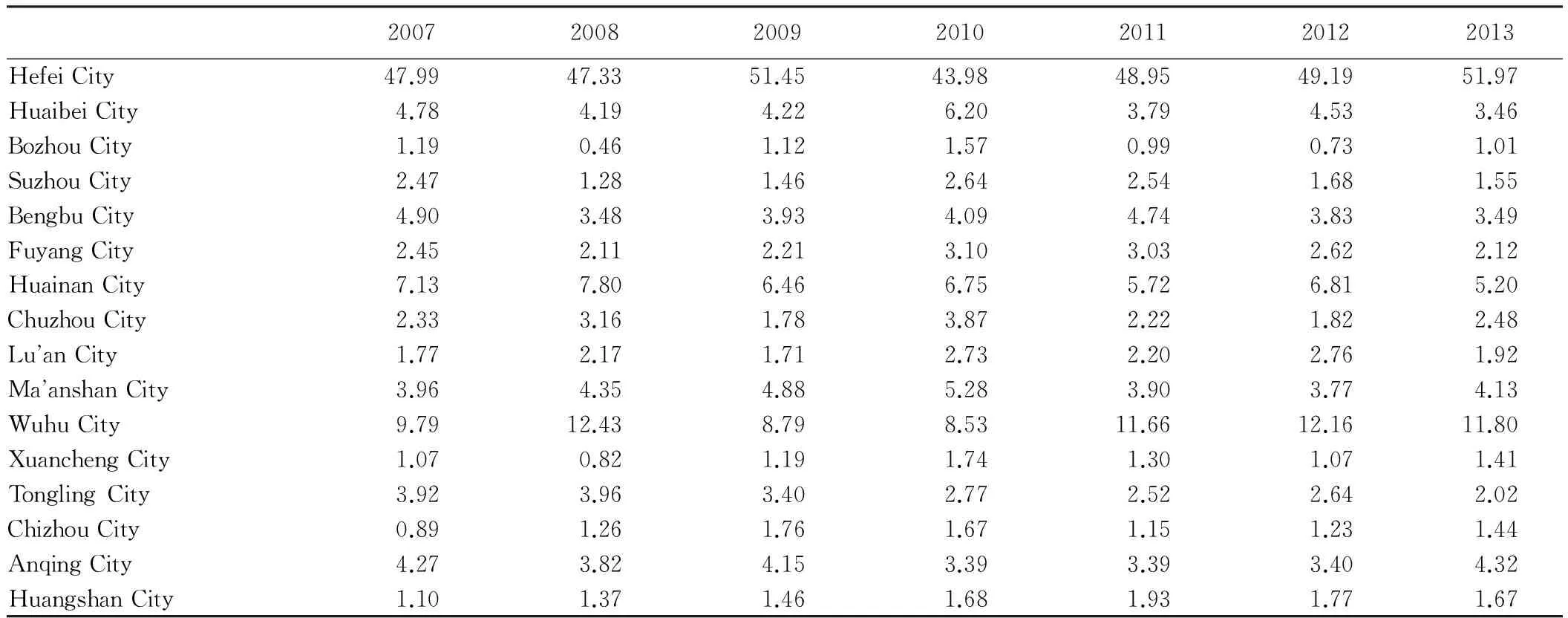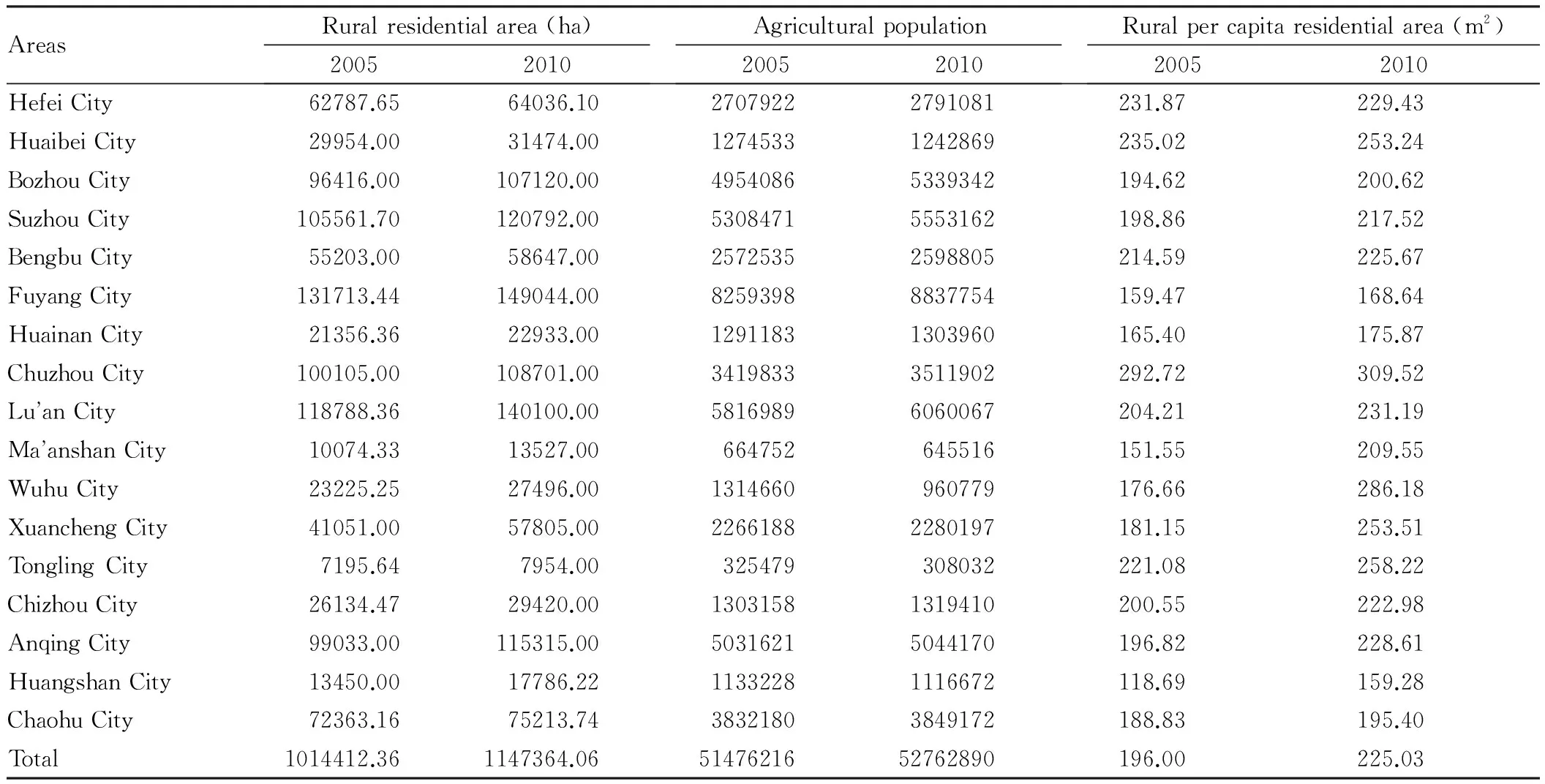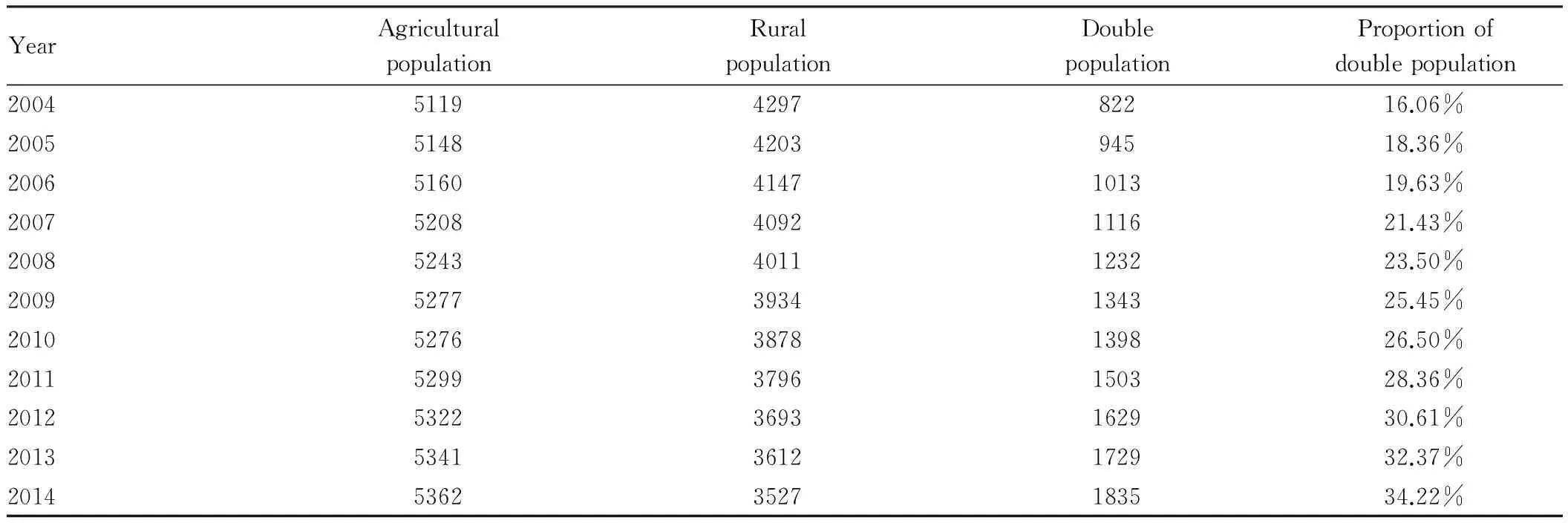A Study of Human-Land Linking Policy Based on Urbanization Away from Home: A Case Study of Anhui Province
, ,2*
1. College of Economics and Management, Anhui Agricultural University, Hefei 230036, China; 2. Institute of Land and Resources, Anhui Agricultural University, Hefei 230036, China
1 Introduction
In 2016 government work report, Premier Li Keqiang points out that it is necessary to deepen the reform of the household registration system, soften the terms on settlement in cities, establish and improve the "human-land-money" linking policy[1]. As early as 2012, Central Plains Economic Zone Plan (2012-2020) approved by the State Council allowed the Central Plains Economic Zone including northern Anhui to steadily push forward the human-land linking and alleviate the waste and inefficient use of land. Anhui Province is in a period of rapid development of urbanization, but there are many problems such as large regional disparities, mismatch between population distribution and resources distribution, and irrational urban scale and structure. In order to get rid of the predicament of serious human resource drain and difficult internal flow, achieve sustained economic development based on rational allocation of resources, optimize population distribution, economic layout and urban element configuration, ensure the supply of human resource, land and other resources in the core areas, achieve stable and adequate urbanization and promote the construction of ecological civilization, Anhui Province needs to enhance the urbanization away from home for the cross-city population in the province, promote the population to cluster in Hefei, Wuhu, and the city belt along the Yangtze River and Huaihe River, and moderately transfer the population in northern Anhui.
2 Current situation of urbanization away from home in Anhui Province
2.1CharacteristicsandtrendsofpopulationflowinAnhuiProvinceAnhui Province is adjacent to the Yangtze River Delta, with convenient transportation, and has gradually developed into the largest province of rural labor migration. The population working outside home for more than half a year occupies more than 30% of rural population (Table 1). However, with economic and urbanization development in Anhui Province in recent years, the continued fast interprovincial outflow of population has been changed, and the scale of population flow within the province continues to grow. Hefei and Wuhu as economic cores show strong appeal for the population.
2.1.1The interprovincial outflow of population in Anhui Province has been reversed. The sixth census data show that Anhui Province is the largest province in terms of interprovincial population outflow scale and proportion. According toStatisticalYearbookofAnhuiProvince, the scale of population working elsewhere for more than half a year continued to growing during 2000-2011, except a slight decline in 2008 due to financial crisis. But the interprovincial population outflow scale peaked in 2011 (11.99 million), and then it continued to decline, and the scale was 10.53 million in 2014. Thus, the interprovincial outflow of population in Anhui Province has been reversed.
2.1.2Anhui has increasing appeal for population. Transfer of industry brings transfer and return of the population, and Anhui Province, as population inflow place, has increasing appeal for population. The sixth census data show that most of people in Anhui Province flow out to the Yangtze River Delta region, accounting for 77.5% of total people flowing out. Since 2010, the projects and funds of the Yangtze River Delta region have continued to shift to Anhui Province, and the growth rate of projects and funds flowing to the province is more than 25%. With the accelerated capital inflow, the population flowing out tends to continuously return.
2.1.3The regions along the Yangtze River have stronger appeal than northern Anhui. By analyzing the changes in various cities’ appeal for population, the cities in the provinces can be divided into three categories according to the growth rate and proportion of cross-city floating population working outside home for more than half a year (average growth rate of 6.4% and average proportion change of 0% in the province). (i) Strong areas (rising proportion, fast-growing scale): Hefei, Wuhu. (ii) Equilibrium areas (steady proportion, fast-growing scale): Chizhou, Huangshan, Xuancheng, Lu’an, Ma’anshan, Chuzhou, Anqing. (iii) Weak areas (decreasing proportion, slow-growing scale): Fuyang, Bozhou, Huainan, Huaibei, Bengbu, Suzhou, Tongling. From the distribution of strong and weak areas, it is found that the regions along the Yangtze River have stronger appeal than northern Anhui, six cities in northern Anhui are all weak areas, and Tongling City is ranked last due to the impact of resource depletion and economic slowdown.
3 The conditions for Anhui to implement human-land linking policy
Based on the overall land use plans in various cities of Anhui Province (2006-2020), the second land survey results in Anhui Province and Anhui Statistical Yearbook, we analyze the rural residential land use change in Anhui Province in 2005 and 2010 (Table 2). "Double population" is roughly calculated by subtracting rural population from agricultural population. If we take simple conversion method and believe that "double population" occupies all of the original homestead in countryside, then the population of "double population" to agricultural population (Table 3) is equal to the population of the land occupied by "double population" to total rural residential land (Table 4)[2].
Table1ThefloatingpopulationworkingacrossthecityinAnhuiProvinceformorethanhalfayearduring2007-2013(%)

2007200820092010201120122013HefeiCity47.9947.3351.4543.9848.9549.1951.97HuaibeiCity4.784.194.226.203.794.533.46BozhouCity1.190.461.121.570.990.731.01SuzhouCity2.471.281.462.642.541.681.55BengbuCity4.903.483.934.094.743.833.49FuyangCity2.452.112.213.103.032.622.12HuainanCity7.137.806.466.755.726.815.20ChuzhouCity2.333.161.783.872.221.822.48LuanCity1.772.171.712.732.202.761.92MaanshanCity3.964.354.885.283.903.774.13WuhuCity9.7912.438.798.5311.6612.1611.80XuanchengCity1.070.821.191.741.301.071.41TonglingCity3.923.963.402.772.522.642.02ChizhouCity0.891.261.761.671.151.231.44AnqingCity4.273.824.153.393.393.404.32HuangshanCity1.101.371.461.681.931.771.67
Table2RuralresidentiallandusechangeinAnhuiProvincein2005and2010

AreasRuralresidentialarea(ha)20052010Agriculturalpopulation20052010Ruralpercapitaresidentialarea(m2)20052010HefeiCity62787.6564036.1027079222791081231.87229.43HuaibeiCity29954.0031474.0012745331242869235.02253.24BozhouCity96416.00107120.0049540865339342194.62200.62SuzhouCity105561.70120792.0053084715553162198.86217.52BengbuCity55203.0058647.0025725352598805214.59225.67FuyangCity131713.44149044.0082593988837754159.47168.64HuainanCity21356.3622933.0012911831303960165.40175.87ChuzhouCity100105.00108701.0034198333511902292.72309.52LuanCity118788.36140100.0058169896060067204.21231.19MaanshanCity10074.3313527.00664752645516151.55209.55WuhuCity23225.2527496.001314660960779176.66286.18XuanchengCity41051.0057805.0022661882280197181.15253.51TonglingCity7195.647954.00325479308032221.08258.22ChizhouCity26134.4729420.0013031581319410200.55222.98AnqingCity99033.00115315.0050316215044170196.82228.61HuangshanCity13450.0017786.2211332281116672118.69159.28ChaohuCity72363.1675213.7438321803849172188.83195.40Total1014412.361147364.065147621652762890196.00225.03
Table3Thechangesin"doublepopulation"anditsshareinagriculturalpopulationinAnhuiProvinceduring2004-2014Unit:104

YearAgriculturalpopulationRuralpopulationDoublepopulationProportionofdoublepopulation20045119429782216.06%20055148420394518.36%200651604147101319.63%200752084092111621.43%200852434011123223.50%200952773934134325.45%201052763878139826.50%201152993796150328.36%201253223693162930.61%201353413612172932.37%201453623527183534.22%
Table4Totalruralresidentiallandandtotallandoccupiedby"doublepopulation"inAnhuiProvincein2005and2010Unit:ha

Year20052010Totalruralresidentialland1014412.361147364.06Totallandoccupiedby"doublepopulation"186246.11304051.48
4 The factors that affect human-land linking policy
There are many factors affecting the labor mobility in the province, and based on relevant research results, we divide the factors that affect urbanization away from home in the province into policy characteristics; personal and family characteristics; domicile environmental characteristics; level of urban development; differences in folk customs and life habits (Table 5). (i) Policy characteristics. From the legislative level, the top-level institutional design is inadequate, and the state and local legislation is not perfect. When Anhui Province makes experiments on human-land linking, it is necessary to fully understand the necessity of having laws for people to follow, and protect the farmers into the city in all aspects of employment, social security, education, census register, so that they can enjoy the legitimate rights and interests. (ii) Personal and family characteristics. Farmers’ personal and family characteristics have a significant impact on the labor flow. Anhui Province should have forethought and adopt different ways, and especially during the Spring Festival, it should make a survey of 12.876 million migrant workers to have a clear understanding about the base number of migrant workers returning home, place of domicile and urbanization trends, and predict the amount of land used for urbanization. If it is "urbanization away from home" in the province, the land quota should be supplied by the place of domicile[4]. (iii) Domicile environmental characteristics. The level of economic development and economic models in the place of domicile significantly affect the labor mobility. Due to high level of economic development and abundant jobs, the Wanjiang city belt has a strong ability to attract the cross-city labor in the province; due to environmental constraints on traditional resource-based industries and rising costs in northern Anhui, the cross-city and interprovincial labor mobility is very high. (iv) Level of urban development. From the point of view of city level, Anhui’s urban population is increasing and city scale is expanding, but the large and medium-sized cities grow slowly, and there is a shortage of large cities with great driving force. Anhui Province should continue to improve the driving force of the central city of Hefei to promote the province’s rapid economic development. (v) Differences in folk customs and life habits. There are great differences in the customs and life habits between north and south of Anhui Province, and human-land linking policy involves a large floating population. If this relationship is not properly handled, it will become a factor affecting social harmony. The migrant workers’ integration into the city is a process of accepting urban values, mode of production, ways of communication and thinking, history, geography and other cultural elements from ideas.
5 Recommendations
5.1PayingparticularattentiontokeylinksofreformandpolicyprioritiesThe rural labor transfer includes three links: rural exit, urban entry and urban integration of migrant workers[5]. Han Jun from Development Research Center of the State Council believes that it is necessary to make a basic bottom line in China, that is, it is impossible to make farmers completely abandon contracted land and homestead to settle in the city the next two or three decades[6]. Therefore, it requires us to change ideas, and respect farmer as rational economic man’s right to choose, clearly understand the policy priorities, in order to promote urbanization away from home, human-land linking, and orderly farmer citizenization in Anhui Province.
5.2BreakingthebarrierstourbanentryIt is necessary to strengthen population concentration and absorption capacity building, and make the central cities relax the constraints on settling in the province and gradually soften the terms on settlement of the population from other provinces. In the main producing areas of agricultural products, key ecological function areas and prohibited development zones, there is a need to implement a proactive population exit policy. Additionally, it is necessary to strengthen compulsory education, vocational education and skills training to enhance farmers’ cross-regional employment capacity, and encourage population to transfer to other provinces or the key development areas in the province.
Table5Thefactorsthataffecthuman-landlinkingpolicy

FactorsContentPolicycharacteristicsTop-levelinstitutionaldesign,employmentinformationguidance,socialsecurityandcontinuation,childse-qualrighttoeducation,householdregistrationsystemreform,andhousingsecuritypolicycoveragePersonalandfamilycharacteristicsPersonalcharacteristics(sex,age,healthstatus,educationlevel,vocationalskills,maritalstatus,etc.),householdcompositionDomicileenvironmentalcharacter-isticsLocaleconomicdevelopment,socialnetwork,villagesgeographiccharacteristics,landtransfer,localvoca-tionaltrainingcapacityLevelofurbandevelopmentUrbanscale(populationsize,built-uparea,GDP),numberofcityjobsandnumberofjobspercapita,matc-hingofindustrialdemandandlabortransfer,levelofpublicservices,levelofurbanmanagementDifferencesinfolkcustomsandlifehabitsDifferencesinlanguage,cultureandlifehabits,discriminationagainststrangers
5.3MakingjointeffortstointegrateintothecityOn the one hand, the level of urbanization in northern Anhui is improved by significantly cutting agricultural population, accelerating construction of beautiful countryside, and promoting agricultural land transfer, so as to promote the development of modern agriculture. On the other hand, it is necessary to encourage the urbanization away from home in the province, and promote moderate flow of labor from northern Anhui to Wanjiang, in order to provide employed population support for the industrial development in the industrial transfer demonstration areas of Wanjiang city belt, and improve the quality of urbanization. Meanwhile, it is necessary to accelerate the equalization of public services, and achieve full coverage of basic public services for the transferred agricultural population.
5.4GuidingtheruralvoluntaryexitIt is necessary to implement homestead system reform. From the incentive mechanism, we have to explore reasonable compensation standards for homestead exit. The design of compensation standards should be based on the construction land benefits in the unified urban-rural land market, to provide housing subsidies for the rural residents settling in the city. It is also necessary to establish paid homestead use system and increase the tax burden to make the cost of holding homestead higher than benefits, and prompt farmers to actively withdraw from the homestead.
5.5Promotingcommonurban-ruraldevelopmentIt is necessary to establish a unified urban-rural land market system, and a set of rules to implement establishment of unified urban-rural land market, so that the governments and the public have rules to follow. There is a need to establish identity files for each plot of rural land, including arable land, collective construction land and homestead; register the land and issue certificate from door to door to clearly define ownership relations; improve transfer payment system, and establish a link between provincial transfer payment and agricultural population transfer.
[1] The State Council of the People’s Republic of China. Chinese government’s annual work report[Z].2016—03—05. (in Chinese).
[2] FU Q. Double occupation of rural-urban land of China during urbanization: situation, mechanism and policy choice[D]. Hangzhou: Zhejiang University, 2007.(in Chinese).
[3] LI Q, LIU L. Assessing land resource carrying capacity of Wanjiang City Belt based on factor index method[J]. Geography and Geo-Information Science,2014(1):56-59.(in Chinese).
[4] YU ZX. On promoting the citizenization of migration rural population using land security policy[J]. Jianghuai Tribune, 2015(3):34-35.(in Chinese).
[5] LIU SJ. A microcosmic judge on the order citizenization of rural migrant workers[J]. Country Review, 2013(7): 21-22, 27-29.(in Chinese).
[6] HAN J, HE YP, JIN SL. Investigation on the citizenization of rural migrant workers[J]. Decision-Making, 2011(9): 20-34. (in Chinese).
 Asian Agricultural Research2016年5期
Asian Agricultural Research2016年5期
- Asian Agricultural Research的其它文章
- Is It Worthwhile for Farmers to Grow Grain?—A Study of Farmers’ Behavior of Growing Grain
- Establishment of Chinese Agricultural Brand Value Scale and Study of Its Reliability and Validity Based on Customer Value
- How to Develop Chinese Rural Tourism in the Context of New Urbanization?
- Chinese Customers’ WTP for Legal Digital Music Downloading
- High Standard Capital Farmland Construction Based on Grain Security
- Research on the Brand Construction of Agritourism Enterprise in Chongqing
